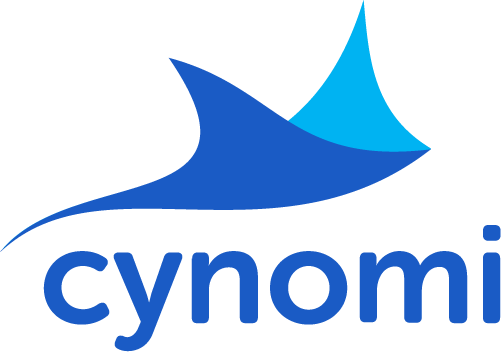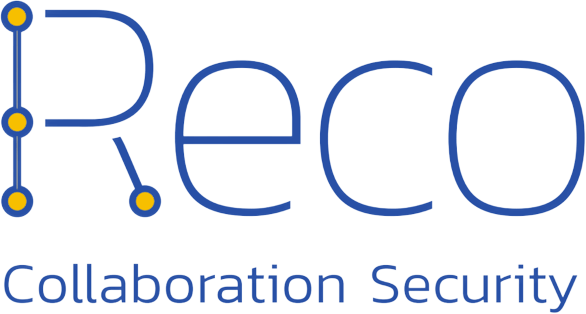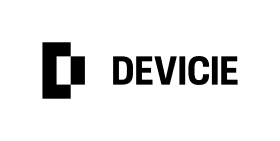
For many founders, a successful exit is a key motivator, but it requires much more than just good timing; it demands a clear, strategic approach from day one. Consider the 3,067 U.S. startups founded in 2018 that used Carta for cap table management: 49% have shut down, 5% were acquired, and just 0.2% — only four — made it to a public listing.
At Insight, we’ve found that successful companies plan for every stage of their journey, all the way through to exit. They approach their growth with an exit in mind, focusing on the right metrics to clearly communicate their trajectory, growth, and resilience. This can help them stay on track and position their business as an appealing opportunity for potential acquirers or public investors.
The key to success is building a strong foundation from the start.
Choose your exit: IPO or acquisition?
The first decision you must make is your endpoint: an initial public offering (IPO), acquisition by a public company, acquisition by a private company, or a private equity takeover? Each requires you to make different decisions as your company grows.
Planning ahead for an IPO
For many companies, the mental image of an exit involves ringing the stock exchange bell. But in reality, the overwhelming majority of founders don’t go down this route.
Of the 7,500 software deals in 2023, just 2% were public listings*.
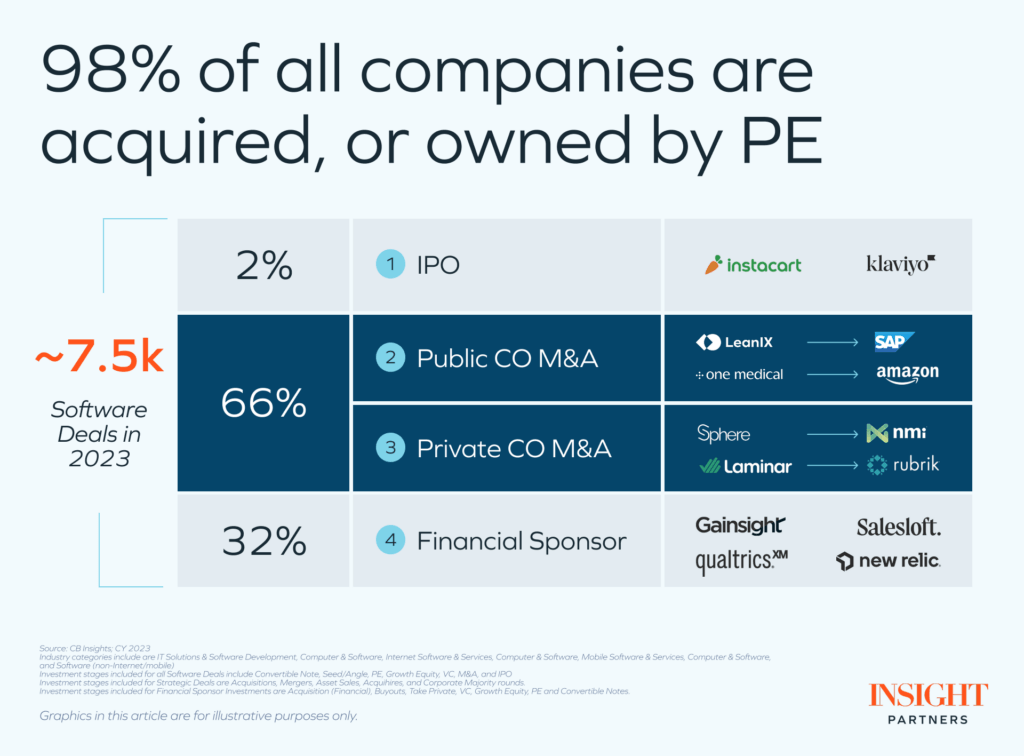
There are multiple reasons why so few companies go public. Many founders simply don’t want to. Regulatory pressures, the requirement to publish quarterly earnings, and a wider loss of control can make it an unappealing route. Public markets can also be volatile, with stock prices driven by investor sentiment rather than long-term fundamentals.
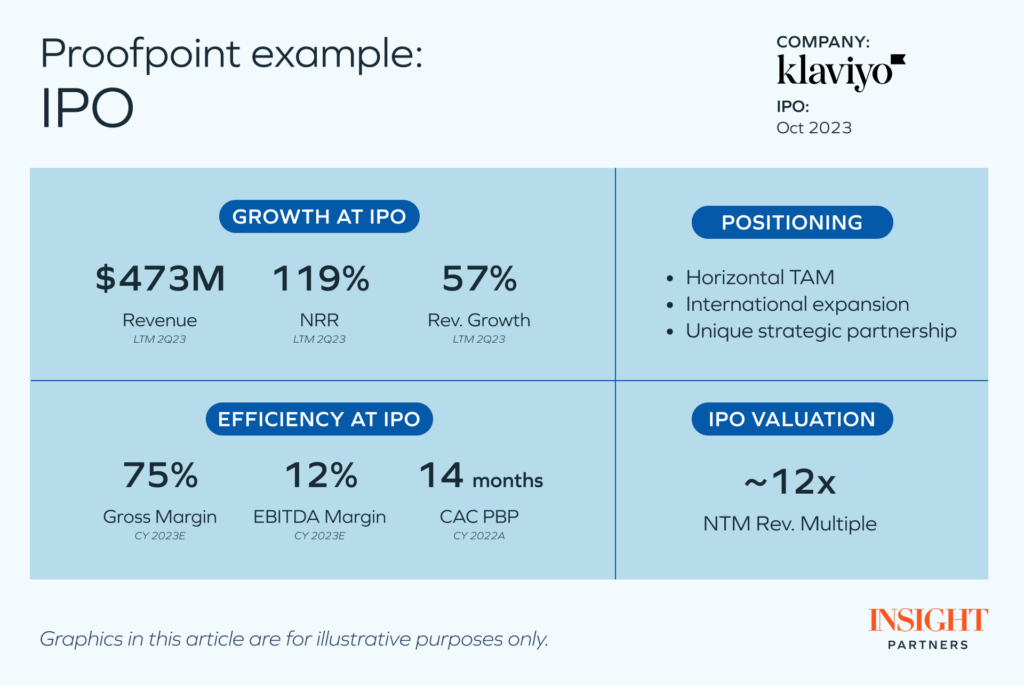
Other companies may not meet the high bar required, especially in this tougher IPO environment. Businesses that make the best IPO candidates generally meet five criteria:
- Address a large market opportunity. Investors will expect many years of constant growth, so you want to make sure that the market is available for you to chase, whether through geographic or product expansion.
- A strong competitive advantage. Your moat should be wide and defensible enough to prove to investors that you have what it takes to remain a sought-after business by customers and investors.
- Consistent high growth — at scale. Investors generally look for over $100M in ARR with a track record of over 40% growth over several years. Best-in-class SaaS businesses typically have net retention greater than 120%.
- A clear path to profitability. Most tech companies adopt a strategy of high growth at scale, which often requires significant investment in customer acquisition. By focusing on unit economics at scale, you can show your investors that your cash usage is fueling efficient growth that will generate profits over time.
- An exceptional team. While an IPO is a financing event, it is also a major marketing event. The most successful and enduring public companies articulate their story continuously, and your senior team must be able to do that.
On top of all of this, the IPO window only opens when the incentives of all four parties — underwriters, investors, management teams, and boards — are aligned.
You can’t predict how those forces will move in the future. One Fed decision, inflation print, or job data release can make going public untenable. You can only control how ready you are when the time to IPO arises.

Acquisition by a public company
The most common form of exit is being acquired by another business. Two-thirds of software deals in 2023 (66%)* followed this path, and many buyers were public companies.
There are a number of reasons a listed company might explore M&A, including:
- Growth: Acquiring a company is often a faster way to scale than building from scratch. For example, instead of building its own AI workload orchestration platform from scratch, NVIDIA acquired Run:ai to accelerate its AI infrastructure capabilities.
- New technology or products: Acquiring a company with innovative tech or unique products can strengthen an existing offering. For example, Salesforce bought Own, which provides backups of SaaS and PaaS data, to enhance its ability to offer robust protection and management solutions to customers.
- Market expansion: Acquisitions can open doors to new markets or customer segments. For example, Whole Foods was acquired by Amazon in 2017 to expand its footprint in the grocery sector. The deal gave Amazon a strong presence in physical retail, allowing it to compete with traditional supermarkets while integrating its e-commerce and Prime services into brick-and-mortar stores.
- Talent: Some acquisitions are less about the product and more about bringing world-class expertise in-house. For example, Google’s 2014 acquisition of DeepMind was a strategic move to secure leading AI researchers, fueling its advancements in artificial intelligence.
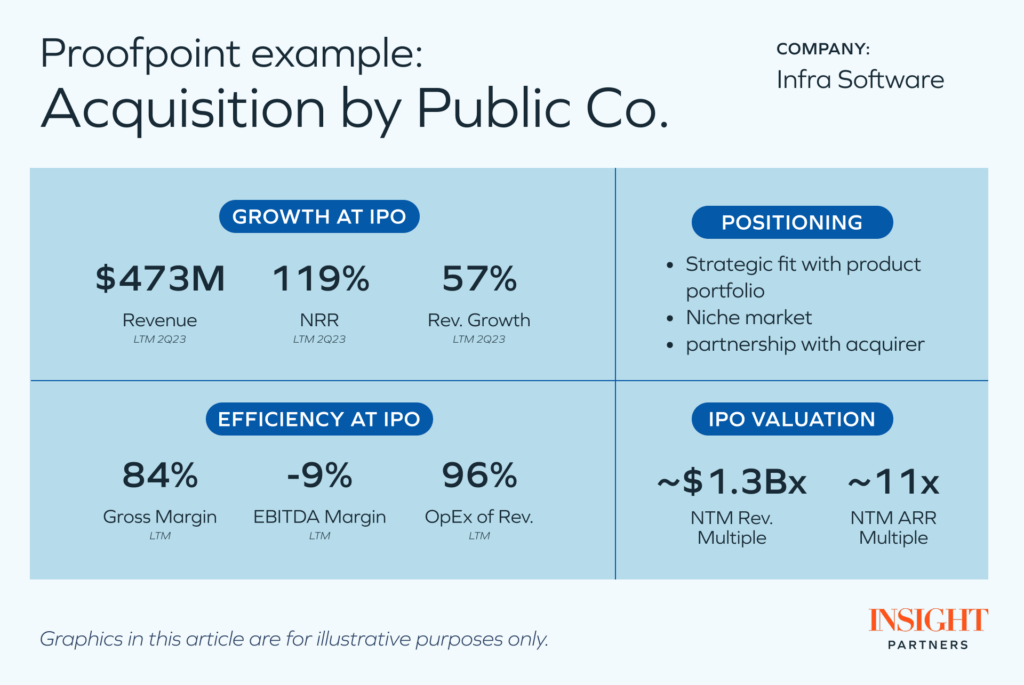
Acquisition by a private company
Your choice of buyer should be strategic, but in many cases, Insight has seen successful exits that are more opportunistic. This balance between strategy and timing can greatly influence the outcome. For example, BlueCat Networks acquired network management software maker LiveAction. “As part of BlueCat, we can leverage the synergies across a much larger business,” explained LiveAction CEO Francine Geist.
At Insight, we expect to see many private-to-private acquisitions over the next two years. Many companies funded at sky-high valuations in 2021 and 2022 may fail to raise another round and are looking to exit instead.
Acquisition by private equity
The final option is to be acquired by private equity. Depending on the strategy, the firm may seek to drive operational improvements, accelerate growth, or prepare for a future exit at a higher valuation. A private equity firm may also inject capital, help streamline operations, or offer strategic guidance to optimize performance.
For example, Insight acquired cloud data company Veeam in 2020 for $5B. At the end of 2024, the company was valued at $15B. Veeam recently took further investment from Microsoft to help build out its AI products.
Other companies take a more winding route that encompasses several exit options. In 2018, Qualtrics, a customer and employer experience management platform, had the metrics and desire to IPO. But in parallel, the company was exploring acquisition options. At the last minute, CEO Ryan Smith decided to sell to German software giant SAP.
In early 2021, SAP spun off Qualtrics and took it public at a valuation of $15B. By 2023, a new owner, Silver Lake, took it private again. Qualtrics is a good example of how a business with a large customer base and strong metrics can afford to be opportunistic.
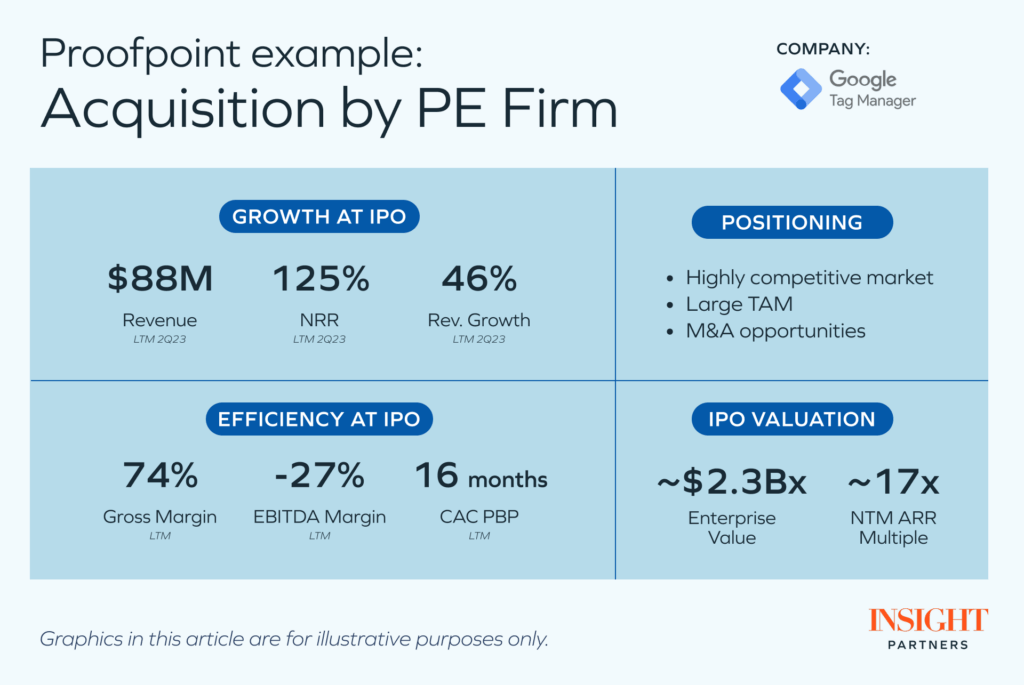
Telling the right exit story
Once you’ve decided how you want to exit, you need a plan to get there. There are a few critical questions to consider:
- If you’re planning to go public, what makes your company an attractive option for the street?
- If you’re looking to sell to a private company, what would make you a valuable acquisition?
- What partnerships are you building now that could lead to future buyers?
- If private equity is part of your plan, how does your business fit their investment goals?
- Could you play a role in a larger business merger, or is there another clear way to create more value?
You need to tell the right story to make the deal make sense.
Nailing your messaging and positioning
Mastercard’s acquisition of intelligence platform, Recorded Future, offers an important lesson in framing. The narrative Mastercard presented to its board and the public was about protecting its customers. Recorded Future’s software is designed to target bad actors committing fraudulent financial transactions. Beyond being a market leader, the company’s global presence positioned it well to serve regions where fraud is most prevalent.
When building your narrative to prepare for an exit, think about the market size and opportunity you have. Most companies operate in vertical industries, meaning they have a finite market size. For example, only so many businesses need to buy core banking software. A minority operates in horizontal industries and can sell to anybody regardless of size or geography.
Depending on which category you fall into, we beleive you should position yourself either as ‘the best house in a small town’ or “a good house in a large city.’”
Gainsight, a customer success software maker, was sold to Vista Equity Partners in 2020. Because it operates in a vertical industry — not everyone needs customer success software — Gainsight framed itself as the best house in a small town. Vista later strengthened its position further, making a number of bolt-on acquisitions.
But storytelling is only part of the equation. You need the metrics and strategy to support your narrative.
Highlighting durable business metrics
Markets are dynamic and difficult to time. What really matters for a successful exit is durability. There are two components to this: growth rate and business efficiency.
How fast is your business growing?
One metric that all acquirers look at is customer retention. If you spend money to acquire customers but quickly lose them, that return on investment is limited. On the other hand, if you can hold onto your customers, your value will compound and contribute positively to your revenue growth.
To show the power of customer retention, let’s look at cybersecurity company Crowdstrike. Its revenue grew from $53M to $481M between 2017 and 2020, with a gross revenue retention (GRR) of 97%. If a hypothetical Company B grew at the same pace but with a GRR of only 80%, its revenue would be about $100M lower over the same period.
That gap widens exponentially as time passes. At the end of 2023, Crowdstrike’s revenue was $2.2B. Company B’s revenue would be $1.2B, a difference of $1B.
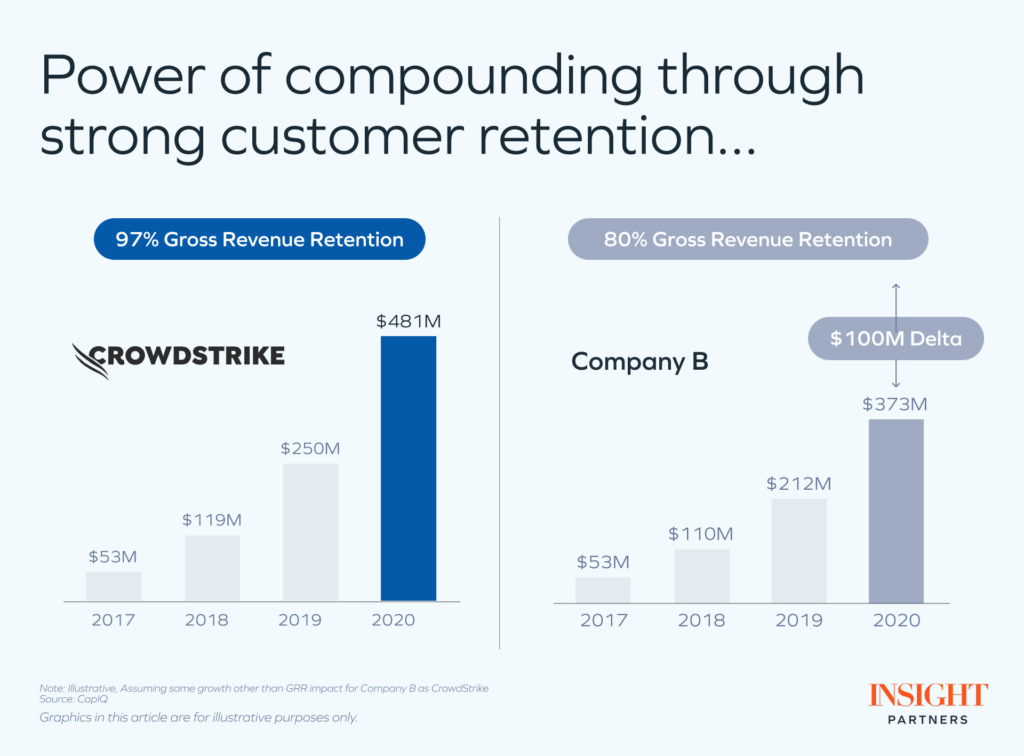
Customer retention is especially important for companies that operate in a small market. If your churn is high, you will run out of potential customers.
How efficient is your business?
The second element of durability is efficiency. Some of the most important metrics to consider include:
- Gross margin. The difference between your revenue and the cost of goods sold (COGS), expressed as a percentage of revenue. For many SaaS companies, this is shrinking because of the high cost of adding AI to their business operations.
- Capital expenditure (CapEx). How are you using funds over the long term? Software tends not to be too CapEx intensive unless you implement AI agents or other expensive services.
- Capital adequacy ratio (CAR) to annual recurring revenue (ARR). How well you convert cash to revenue.
- Payback period. How long it takes to convert bookings into cash.
- Market size. How you can grow your market through time, e.g. new products, markets, or acquisitions.
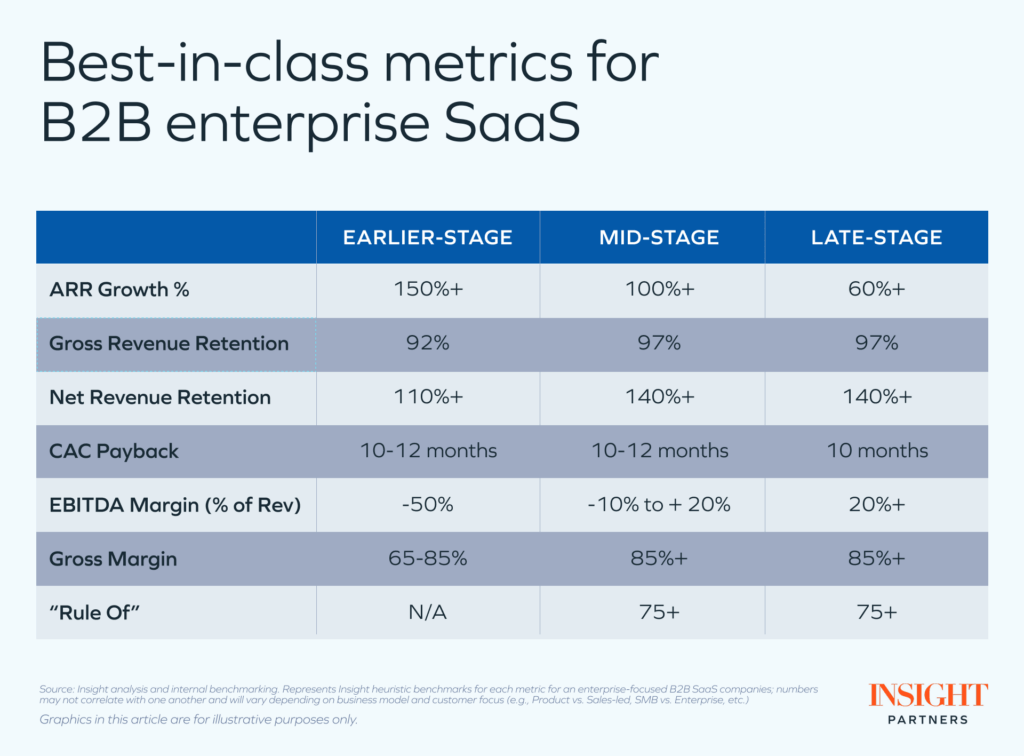
Proof points may differ by stages of growth because it’s difficult to sustain growth at scale. For example, a 150% ARR growth rate is much more impressive if you’re going from $10M to $25M than from $1M to $2.5M.
Microsoft’s Azure cloud computing business is one of the strongest examples of outlier growth at the late stage. Its revenue growth for Q1 FY2025 was a massive 33%. By comparison, most public companies today are growing at 20%.
Progress since the last business milestone
An important measure of momentum is what some call ‘strategic distance,” which has five drivers:
- Revenue quantum. How much have revenues grown since your last raise?
- Diversification. Are you still a single-product portfolio? Have you brought out new features? Have you acquired a company? Have you brought out new products?
- New products and innovation. Is there more you can sell back to existing customers to increase your share of wallet?
- Expanded TAM. Have you entered new geographies or segments?
- Partner lock-in. Do you have distribution agreements?
Picking the right exit partner
So far, we’ve focused on how to prepare your company for an exit. But, for an acquisition, there are two parties involved. After closing the deal, you must also consider choosing the right partner to ensure future success.
While a high valuation is appealing, you may need to look beyond the numbers and consider the long-term potential of the partnership. A well-chosen partner can also provide critical operational support, enhance your company’s credibility in the market, and provide access to capital or expertise that can accelerate growth.
*Note: Insight Partners has invested in LiveAction, Veeam, Own, Run:ai, Qualtrics, Recorded Future, and Gainsight.
*Data used in this article is publicly available with analysis from Insight, specifically:
Source: CB Insights; CY 2023 Industry categories include are IT Solutions & Software Development, Computer & Software, Internet Software & Services, Computer & Software, Mobile Software & Services, Computer & Software, and Software (non-Internet/mobile) Investment stages included for all Software Deals include Convertible Note, Seed/Angle, PE, Growth Equity, VC, M&A, and IPO Investment stages included for Strategic Deals are Acquisitions, Mergers, Asset Sales, Acquihires, and Corporate Majority rounds. Investment stages included for Financial Sponsor Investments are Acquisition (Financial), Buyouts, Take Private, VC, Growth Equity, PE and Convertible Notes.


